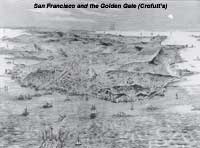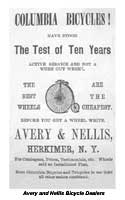Herkimer, situated on the Mohawk River and the Erie Canal, is in the
beautiful valley formed by the Mohawk River that extends 100 miles from
Albany to Utica/Rome, New York. The Valley was caught up in the bloody
frontier struggle between the British/Indian forces and the American
patriots during the Revolutionary War. The Nellis family and their
relations, who had been in the Mohawk Valley since 1723, played a part
in the struggle for independence. They were part of the Palatine Germans
who had come to the Hudson Valley in 1710 and soon began moving into the
Schoharie and Mohawk regions in search of land and prosperity. In the
French and Indian War they had fought with the British to defend their
homes, but during the Revolution they opposed the English and fortified
Herkimer by constructing Fort Dayton.
With the coming of peace and the building of the Erie Canal along the
banks of the Mohawk the region prospered, and by the end of the Civil
War the town of Herkimer was a bustling community of 3,000. A respected
resident of the village was
 George W. Nellis, Sr. who was born in 1835
and married Melinda Witherstine before the War. The couple had four
children who lived to maturity - Irving, Byron, Clara, and George, Jr.
who was born in 1865. The family home was at 44 Eastern Avenue and city
directories indicate that the father engaged in farming and was a
teamster and a cabinetmaker. He was also interested in public education
and for a number of years served as a trustee of School District #2. His
children attended the District's one-room school and although records
are incomplete, it is known that in 1877 three Nellis children were
enrolled - Byron age 18, Clara age 17, and George age 12. A good basic
education allowed Byron and his older brother, Irving, to go on for
medical training. Irving practiced in Herkimer and Byron moved to
Weedsport. It is not known when George left school but by 1881 he began
a three-year apprenticeship with the Herkimer Democrat newspaper and
lived with his parents at 44 Eastern Avenue. He also served as the Utica
Globe's correspondent in Herkimer and in 1885 the Globe published his
scholarly account of the history of newspapers in Herkimer County. George W. Nellis, Sr. who was born in 1835
and married Melinda Witherstine before the War. The couple had four
children who lived to maturity - Irving, Byron, Clara, and George, Jr.
who was born in 1865. The family home was at 44 Eastern Avenue and city
directories indicate that the father engaged in farming and was a
teamster and a cabinetmaker. He was also interested in public education
and for a number of years served as a trustee of School District #2. His
children attended the District's one-room school and although records
are incomplete, it is known that in 1877 three Nellis children were
enrolled - Byron age 18, Clara age 17, and George age 12. A good basic
education allowed Byron and his older brother, Irving, to go on for
medical training. Irving practiced in Herkimer and Byron moved to
Weedsport. It is not known when George left school but by 1881 he began
a three-year apprenticeship with the Herkimer Democrat newspaper and
lived with his parents at 44 Eastern Avenue. He also served as the Utica
Globe's correspondent in Herkimer and in 1885 the Globe published his
scholarly account of the history of newspapers in Herkimer County.
By the middle of the 1880s, Nellis became interested in bicycling and
acquired a high wheel, perhaps one that had belonged to an elder brother
or to another wheelman. Herkimer had discovered cycling quite early and
in the 1860s local machinist Henry M. Quackenbush built several
velocipedes. Quackenbush also acquired an early high wheel bicycle in
partnership with his cousin, Charles Rasbach, and late in the century
the Quackenbush Company was manufacturing a Bicycle Rifle.
In 1886 or 1887, Nellis acquired the fully nickel-plated Columbia Expert
used on his cross-country ride. He may have obtained it for below the
retail price of $150 since by 1886 he and partner Charles Avery had a
sideline business selling
 Columbia bicycles. This business probably
consisted of having catalogs and sales literature used to take orders
from venturesome men who wanted to keep up with the times. There was no
formally organized bicycle club in Herkimer at this time but there was a
group of wheelmen who sported about on their high-wheel machines. Columbia bicycles. This business probably
consisted of having catalogs and sales literature used to take orders
from venturesome men who wanted to keep up with the times. There was no
formally organized bicycle club in Herkimer at this time but there was a
group of wheelmen who sported about on their high-wheel machines.
Nellis was an active rider, although one local paper reported that his
rides seldom exceeded fifty miles in length. He also showed curiosity
about the development of cycling and must have read numerous books and
periodicals about the subject. In May 1887 he published a solid article
on "Cycling in America" in the Herkimer Citizen. He explained the slow
adoption of cycling in this country and blamed the situation, in part,
on English machines that were not well constructed to withstand the
rigors of American roads. The turning point, in his view, was the
organization of the Pope Manufacturing Co. in 1877. "So rapid was the
growth after the first machines were turned out that other manufacturers
were attracted to the business and we now have eight firms engaged in
cycle making of various descriptions. From a simple means of pleasure,
cycling has advanced to a practical, safe and constantly enlarging
vocation, of gigantic proportions".We now boast of better machines,
better riders and will soon possess better roads than any country on the
globe."
Nellis also gave attention to a special form of cycling. "As the sport
widened and prospered, new converts were found at every turn and
gradually long-distance riding became an attractive feature".The first
noted undertaking was made in 1883, by Karl Kron, who rode from Detroit,
Michigan to Staunton, Virginia, a distance of 1,422 miles in about 25
days. This trip was made on a Columbia bicycle and averaged 42 miles per
day. The next important event in cycling history is found in the
wonderful trip of Thomas Stevens in 1884. He started from San Francisco,
April 22 and reached Boston August 4, covering the 3,500 miles in 105
days. Stevens also rode a Columbia and on reaching Boston, the Pope
Manufacturing Co. furnished his expenses to continue his trip around the
world (Nellis was not correct in this matter. The company provided
Stevens with an Expert Columbia, but funds for the world tour came from
Outing magazine). His success
persuaded others to attempt the journey
and in 1886 George B. Thayer, F. E. Van Meerbeke, and S. G. Speir rode
across the Continent on bicycles." We also learn from the article that
Nellis had studied the route used to cross the country and conditions in
the West. "The course usually taken by transcontinental tourists follows
the line of the Union Pacific railroad and passes thro' New York, Ohio
or Canada, Indiana, Illinois, Iowa, Nebraska, Wyoming, Utah, Nevada and
California. Autographed letters in the writer's possession from these
wheelmen state that the trip is engendered with far less danger than is
supposed. Mr. Thayer says that in crossing the Rocky Mountains, a rider
does not notice the fact the grade is so gradual. The most to fear is an
absence of water on the plains, a fact which cannot be remedied, but
must be endured. At this time of year a rider will encounter continuous
heavy trade winds, which last for three months and render riding at
times difficult. The inhabitants of western farms are hospitable to a
degree seldom found in the east, and we have yet to learn of a case when
a traveler on a bicycle has been refused food or shelter."
The benefits of such an arduous journey were noted. "In touring across
the continent one will meet with adventures to be had in no other way.
The novelty of his position attracts universal attention of itself and a
close observer of human nature can make the trip of vast benefit."
Nellis also recognized the trip would contribute to his journalist
career by providing a grand opportunity to provide a thorough report for
the readers of the papers carrying his accounts. "The distance to be
traveled each day entirely depends upon the roads one encounters as well
as upon the nature of the country. Then, too, rainy weather is almost a
complete barrier to a cyclist and on such occasions he usually puts in
time rubbing up his wheel, seeing the town, and varying the programs by
entertaining his companions with thrilling accounts of hair breadth
escape on the Erie Canal of New York State." Practical matters were also
considered. "No baggage is carried beyond articles of absolute
necessity. Weight is an important desideratum and beyond a pair of hose,
a wrapper and handkerchiefs, no extra clothing is necessary to the
economical bicyclist. These are usually carried in a small traveling bag
on the bicycle, and the entire machine and baggage will not weigh over
42 pounds."
We have no list of items actually carried on the ride, but his narrative
does mention a satchel strapped to the bars or backbone, a derringer, a
rubber tube for drinking, a road map, a L.A.W. Road Book, a railroad
chart showing section houses, a few items of clothing, and some writing
materials. It is not known how much money was carried, but additional
funds could be telegraphed to him at stations on his route.
It is clear from the article that Nellis was quite familiar with the
cycling situation in the era and that the trip was not a
spur-of-the-moment decision. Many months of planning were needed to
contact men familiar with riding conditions in the west. A route was
selected and a tentative schedule was established so mail from home
could be waiting for him at several cities, approximately 500 miles
apart along the way. There was also correspondence with former Herkimer
residents who now resided in towns he would pass through. They would be
expecting him and accord hospitality and a link with his Herkimer home.
A late May departure was decided on in hopes of avoiding the worst of
the muddy spring roads in the east and allowing an August arrival in San
Francisco that would eliminate the danger of encountering snow in the
Rocky and Sierra Nevada mountains.
Nellis may have sought support for his trip from bicycle czar Colonel
Pope, but he did not obtain any assistance. When the Little Falls News
reported that Pope was providing a bicycle and financing the journey,
Nellis responded in the pages of the Little Falls Evening Times. "The
Pope Manufacturing Co. did not furnish my bicycle nor do they pay my
expenses. I purchased my own wheel and the cashier of the Herkimer bank
will substantiate it. I also pay my own expenses and I leave it to the
cashier to prove the same."
Even without Company support, Nellis certainly favored Columbia bicycles
and often mentioned that he was riding a Columbia. He stopped at Pope
Manufacturing headquarters in Chicago, mentioned Columbia dealers in
other cities, sent at least one telegram on the status of his ride to
Pope, and permitted Pope to borrow and exhibit his machine after the
transcontinental ride.
|


